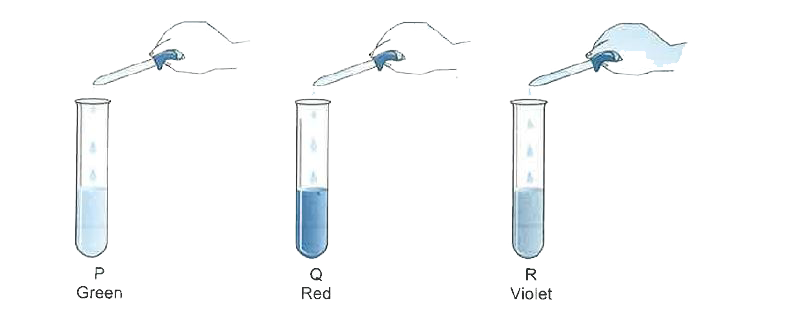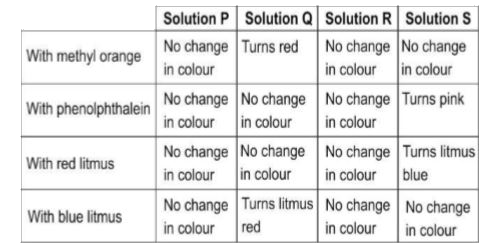P Q R are different colourless solids while S is a colourless solution. They are in random order Sodium chloride NaCl Calcium carbonate CaCO3 Acetic acid CH3 COOH and Phenolphthalein indicator. Small amount of the above substances were added in pairs e.g.P with Q; Q with R etc. to a small amount of water in a test tube. They give the following results as shown in the observation table.Observations table :PQRQNo reaction-No reactionRDark Pink ColourNo reaction-SNo reactionNo reactionEffervescenceThen the chemicals arePQRSaNaClCaCO3CH3COOHPhenophthaleinbPhenophthaleinNaClCaCO3CH3COOHcCH3COOHPhenophthaleinNaClCaCO3dCaCO3CH3COOHPhenophthaleinNaCl
Related Solutions
Read the given passage and answer the questions.
P, Q, R are different colourless solids, while S is a colourless solution. They are in random order) Sodium chloride (NaCl), Calcium Carbonate , Acetic acid and Phenolphthalein indicator. Small amount of the above substances were added in pairs (e.g. P with Q, Q with R etc.) to a small amount of water in a test tube. They give the following results as shown in the observation table.
Observation Table:

Which of the following reaction is incorrect ?
View SolutionRead the given passage and answer the questions.
P, Q, R are different colourless solids, while S is a colourless solution. They are in random order) Sodium chloride (NaCl), Calcium Carbonate , Acetic acid and Phenolphthalein indicator. Small amount of the above substances were added in pairs (e.g. P with Q, Q with R etc.) to a small amount of water in a test tube. They give the following results as shown in the observation table.
Observation Table:

The chemicals are:

View SolutionRead the given passage and answer the questions.
P, Q, R are different colourless solids, while S is a colourless solution. They are in random order) Sodium chloride (NaCl), Calcium Carbonate , Acetic acid and Phenolphthalein indicator. Small amount of the above substances were added in pairs (e.g. P with Q, Q with R etc.) to a small amount of water in a test tube. They give the following results as shown in the observation table.
Observation Table:

If acetic acid and hydrochloric acid of same concentration are taken, HCl is a stronger acid because it contains:
View SolutionRead the given passage and answer the questions.
P, Q, R are different colourless solids, while S is a colourless solution. They are in random order) Sodium chloride (NaCl), Calcium Carbonate , Acetic acid and Phenolphthalein indicator. Small amount of the above substances were added in pairs (e.g. P with Q, Q with R etc.) to a small amount of water in a test tube. They give the following results as shown in the observation table.
Observation Table:

The chemicals that can be used as an acid base indicator by a visually impaired student is _____ .
View SolutionA student takes about 5 mL distilled water in four test tubes marked P, Q, R and S. He dissolves sodium chloride in P, potassium chloride in Q, calcium chloride in R and magnesium chloride in S. After that he adds equal amount of soap solution in each test tube. On shaking the solution of each test tubes he would observe a good amount of lather in the test tubes marked
View SolutionOn adding a few drops of universal indicator solution to three unknown colourless solutions P,Q, and R taken separately in three test-tubes shown in the diagrams, a student observed the changes in colour as green in solution P red in solution Q and violet in solution R . The decreasing order of the pH of the three solutions is:
View SolutionOn adding a few drops of universal indicator to three unknown colourless solutions (P), (Q) and (R ) taken separately in three test tubes shown in the following diagrams, a student observed the changes in colour as green in (P ), red in (Q) and violet in (R ). What will be the decreasing order of pH ?

View SolutionGive reason for the following:
Colourless concentrated sulphuric acid in a test tube changes to blue on adding a small piece of copper to it.
View SolutionA colourless inorganic compound (P) decomposes on heating to give two products (Q) and (R). (Q) is a colourless neutral gas with a sweet odour which when burnt with phosphorous produces a strong dehydrating agent (S) while (R) is a neutral liquid at room temperature. Identify P, Q, Rand S.
View SolutionWhen a small amount of HCI is added to a buffer solution of acetic acid and sodium acetate
View SolutionWhen a small amount of HCI is added to a buffer solution of acetic acid and sodium acetate
View SolutionWhat happens when dil is added to a small amount of sodium carbonate taken in a test tube?
View SolutionAnand took four colourless solutions P, Q, R and S, and performed the following tests. What is the definite conclusion that Anand can reach?

View SolutionAre the following pair of sets equal? Give reasons
.
View SolutionOn adding phenolphthalein indicator to a colourless solution, no change is observed. The nature of the solution may be
View SolutionA small amount of sodium hydroxide solution is added to a small pieces of granulated zinc metal in a test tube. Which of the following represent correct equation?
View SolutionIn three test tubes 'A', 'B', 'C' with solutions of different substances were added a few drops of China rose indicator. The colours shows in these test-tubes were magenta, colourless and green respectively. Select the correct set indicating the substance whose solution are there in these test-tubes.
View Solutionনিম্নলিখিত রাশির বর্গ নির্ণয় করো :
View Solutionনিম্নলিখিত রাশির বর্গ নির্ণয় করো :
View SolutionTo mixture of acetic acid and sodium acetate a further amount of sodium acetate is added. The pH of the resultant solution
View Solution